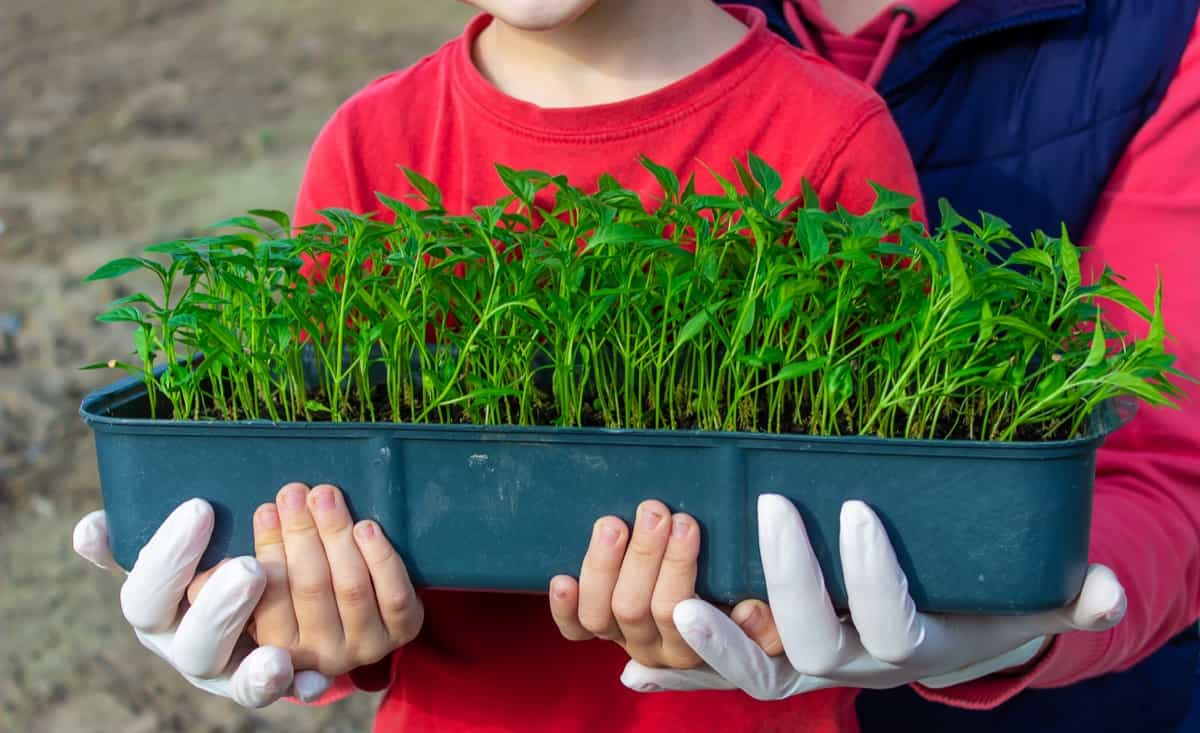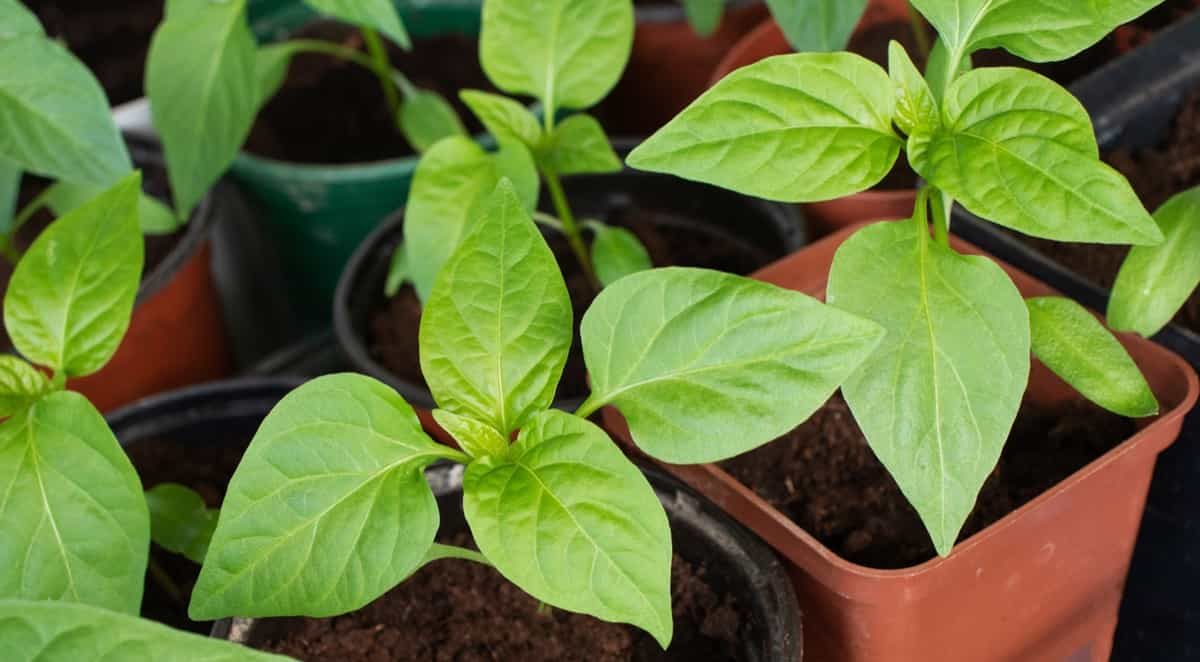Transplanting pepper seedlings can be rewarding, especially for gardening enthusiasts who enjoy growing their plants from seeds. However, the success of the process greatly depends on factors such as timing, conditions, and the general health of the seedlings.

Critical considerations include how deep to transplant pepper seedlings, when to thin pepper seedlings, how to transplant mature pepper plants, pepper plant transplant shock, and when to fertilize pepper seedlings. This article serves as a detailed guide, shedding light on the best time and practices for transplanting pepper seedlings.
When to Transplant Pepper Seedlings
When is the Best Time to Transplant Pepper Seedlings?
The best time to transplant pepper seedlings is when they have at least two sets of true leaves. True leaves are the second set of leaves a seedling produces after the first set, known as the cotyledon or ‘seed leaves’. Waiting until the pepper seedlings have developed a strong root system and at least two sets of true leaves will ensure they can withstand the shock of transplanting.
How Do I Know if My Pepper Seedlings are Ready for Transplanting?
Recognizing when your pepper seedlings are ready for transplanting is vital. Typically, it’s time to move them to bigger pots when they’ve developed their second set of true leaves. Additionally, if you notice that the plants are becoming root-bound, meaning the roots are starting to circle the container or grow out of the drainage holes, they’re ready for more space. However, transplanting pepper plants to bigger pots should be done gently to avoid causing transplant shock.
What Conditions Should I Check Before Transplanting Pepper Seedlings?
Before moving your pepper seedlings, ensure they are healthy and that the environmental conditions are conducive to their growth. Opt for soil that’s both well-draining and abundant in organic content. The temperature of the soil should be warm, ideally above 60 degrees Fahrenheit. Pepper seedlings thrive in full sun, so they should receive at least six hours of direct sunlight daily. Additionally, check for signs of pests or diseases, as these could severely impact the health of your transplanted seedlings.
Can I Transplant Pepper Seedlings Directly Into the Garden?
While it is possible to transplant pepper seedlings directly into the garden, the process requires careful consideration. If the seedlings are too small or weak, they might not survive the transition. Therefore, it is typically safer to transplant them into a larger pot, allowing them to develop further before eventually moving them into the garden. This approach also minimizes the chances of pepper plant transplant shock, which can occur due to a sudden change in the plant’s environment.
In case you missed it: 10 Best Hot Peppers to Grow in Your Garden: Types and Varieties

Should I Harden Off My Pepper Seedlings Before Transplanting?
Hardening off your pepper seedlings before transplanting is an essential step. This process involves gradually exposing the seedlings to outdoor conditions to prepare them for environmental change. Start by placing the seedlings outdoors in a shaded area for a few hours each day, gradually increasing the time and exposure to sunlight over 1-2 weeks. This helps the seedlings to acclimatize and can significantly reduce transplant shock.
What Temperature is Ideal for Transplanting Pepper Seedlings?
Pepper seedlings prefer warm temperatures. The soil temperature should be consistently above 60 degrees Fahrenheit before transplanting the seedlings. Nighttime temperatures should also be above 50 degrees Fahrenheit. If the temperatures are still too cold, it’s best to wait or to keep the seedlings indoors or in a greenhouse. Transplanting peppers too early, when the soil is still cold, can stunt their growth.
How Much Sunlight Do Pepper Seedlings Need Before Transplanting?
Before transplanting, pepper seedlings should receive at least 6-8 hours of direct sunlight each day. This helps them to grow strong and healthy, preparing them for the transition. If you’re growing your seedlings indoors, you might need to use grow lights to ensure they receive enough light. Lack of sunlight can lead to spindly, weak plants less likely to survive transplanting.
What Type of Soil Is Suitable for Transplanting Pepper Seedlings?
Regarding soil, pepper seedlings prefer a well-draining mix rich in organic matter. The pH should ideally be between 6.0 and 6.8. Compost or well-rotted manure can help enrich the soil and provide the seedlings with the nutrients they need to thrive. The soil should also be loose and friable, allowing the roots to penetrate easily and access water and nutrients. Remember, when transplanting, consider how deep to transplant pepper seedlings – the hole should be deep enough to cover the root ball completely.
Can I Use Fertilizer When Transplanting Pepper Seedlings?
Fertilizer can be beneficial when transplanting pepper seedlings. However, timing is key – the ideal time is usually a few weeks after transplanting once the plants have had time to settle into their new environment. Too much fertilizer immediately after transplanting can cause the seedlings to focus more on leaf growth rather than establishing a strong root system. Therefore, be mindful of when to fertilize pepper seedlings to ensure optimal growth.
In case you missed it: How to Treat Brown Spots on Pepper Plant Leaves Naturally: Causes, Fix With Effective Organic Home Remedies

Are There Any Pests or Diseases I Should be Aware of When Transplanting Pepper Seedlings?
When transplanting pepper seedlings, being aware of potential pests and diseases is crucial. Aphids, cutworms, and pepper weevils are some pests that can cause significant damage. Common diseases include bacterial spots, fungal diseases like anthracnose, and viral diseases like mosaic virus.
To prevent these issues, maintain good hygiene practices, ensure proper spacing between plants for good airflow, and monitor your plants regularly for signs of trouble. Healthy plants are better at fighting off pests and diseases, making proper care for your pepper seedlings the top preventive action.
Can I Replant the Same Pepper Seedlings Multiple Times?
Transplanting pepper seedlings multiple times can indeed be beneficial, as it promotes a strong root system. As a rule of thumb, you may want to transplant your seedlings once they become root-bound in their current pots. Each time, ensure to move them to slightly larger pots, taking care not to disturb the roots too much. This process, also known as ‘potting on,’ can help to keep the plants growing vigorously.
Nevertheless, during each transplanting process, be mindful of potential pepper plant transplant shock, which can occur due to a sudden change in the plant’s environment. You can facilitate successful multiple transplants by using a well-draining soil mix, ensuring a proper transplant depth, and maintaining optimal conditions.
In case you missed it: Homemade Garlic and Pepper Spray for Pests and Disease Control: Recipe for Organic Benefits of Plants

Conclusion
Successful transplanting of pepper seedlings relies on careful timing, the right conditions, and well-prepared seedlings. The factors discussed above, from the depth of transplantation to the right time to fertilize, play crucial roles in determining the survival and overall health of the seedlings post-transplant.
Ensuring the seedlings are hardened off before the move, placed in a favorable environment, and regularly monitored for pests or diseases significantly improves their chances of thriving. Gardening can be a trial-and-error process, so don’t get discouraged if things don’t go perfectly the first time. With each attempt, you gain valuable experience and knowledge that makes you a better gardener.
- Feed Your Flock for Less: Top 10 Tips to Save on Chicken Feed
- Ultimate Guide to Ossabaw Island Hog: Breeding, Raising, Diet, and Care
- Hatching Answers: The Top 10 Reasons Your Chickens Aren’t Laying Eggs
- Eggs and Economics: Breaking Down the Cost of Raising Backyard Chickens
- Defend Your Greens: Proven Methods to Keep Iguanas Out of Your Garden
- Ultimate Guide to Cinnamon Queen Chicken: A Comprehensive Guide for Beginners
- Ultimate Guide to California Tan Chicken: Breeding, Raising, Diet, Egg-Production and Care
- Ultimate Guide to Marsh Daisy Chicken: Breeding, Raising, Diet, and Care
- 10 Types of Chicken Farming Businesses You Can Start for Profits